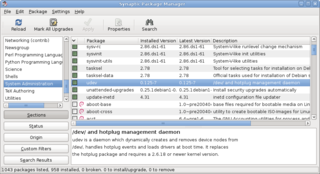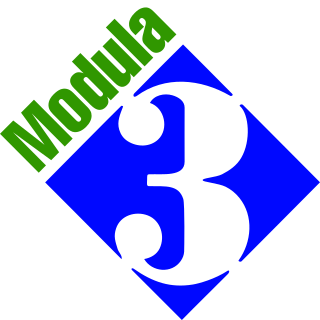Related Research Articles

Digital Equipment Corporation, using the trademark Digital, was a major American company in the computer industry from the 1960s to the 1990s. The company was co-founded by Ken Olsen and Harlan Anderson in 1957. Olsen was president until he was forced to resign in 1992, after the company had gone into precipitous decline.

OpenVMS, often referred to as just VMS, is a multi-user, multiprocessing and virtual memory-based operating system. It is designed to support time-sharing, batch processing, transaction processing and workstation applications. Customers using OpenVMS include banks and financial services, hospitals and healthcare, telecommunications operators, network information services, and industrial manufacturers. During the 1990s and 2000s, there were approximately half a million VMS systems in operation worldwide.

A package manager or package-management system is a collection of software tools that automates the process of installing, upgrading, configuring, and removing computer programs for a computer in a consistent manner.

Modula-3 is a programming language conceived as a successor to an upgraded version of Modula-2 known as Modula-2+. It has been influential in research circles, but it has not been adopted widely in industry. It was designed by Luca Cardelli, James Donahue, Lucille Glassman, Mick Jordan, Bill Kalsow and Greg Nelson at the Digital Equipment Corporation (DEC) Systems Research Center (SRC) and the Olivetti Research Center (ORC) in the late 1980s.

The Systems Research Center (SRC) was a research laboratory created by Digital Equipment Corporation (DEC) in 1984, in Palo Alto, California.

SCons is a computer software build tool that automatically analyzes source code file dependencies and operating system adaptation requirements from a software project description and generates final binary executables for installation on the target operating system platform. Its function is analogous to the traditional GNU build system based on the make utility and the autoconf tools.
Maven is a build automation tool used primarily for Java projects. Maven can also be used to build and manage projects written in C#, Ruby, Scala, and other languages. The Maven project is hosted by The Apache Software Foundation, where it was formerly part of the Jakarta Project.

Mantis Bug Tracker is a free and open source, web-based bug tracking system. The most common use of MantisBT is to track software defects. However, MantisBT is often configured by users to serve as a more generic issue tracking system and project management tool.
rPath, Inc. was a technology company based in Raleigh, North Carolina, that developed technology to automate the process of constructing, deploying, and updating software. rPath modeled and managed components and dependencies under version control. It acted as a model-driven and version-controlled repository, as well as a software distribution hub.
AdvFS, also known as Tru64 UNIX Advanced File System, is a file system developed in the late 1980s to mid-1990s by Digital Equipment Corporation for their OSF/1 version of the Unix operating system. In June 2008, it was released as free software under the GPL-2.0-only license. AdvFS has been used in high-availability systems where fast recovery from downtime is essential.

The Itsy Pocket Computer is a small, low-power, handheld device with a highly flexible interface. It was designed at Digital Equipment Corporation's Western Research Laboratory in Palo Alto to encourage novel user interface development—for example, it had accelerometers to detect movement and orientation as early as 1999.
Modula-2+ is a programming language descended from the Modula-2 language. It was developed at DEC Systems Research Center (SRC) and Acorn Computers Ltd Research Centre in Palo Alto, California. Modula-2+ is Modula-2 with exceptions and threads. The group which developed the language was led by P. Rovner in 1984.
The Environment Modules system is a tool to help users manage their Unix or Linux shell environment, by allowing groups of related environment-variable settings to be made or removed dynamically.
SmartFrog is a Java based open-source framework for helping host large-scale applications across component-based distributed system. It is proposed to make the design, configuration, deployment and management of distributed systems easier, correct and automatic. SmartFrog mainly consists of three aspects: SmartFrog Language, a runtime system, and a library of SmartFrog components that implement the SmartFrog component model.

sbt is an open-source build tool which can build Java, Scala, and Kotlin projects. It aims to streamline the procedure of constructing, compiling, testing, and packaging applications, libraries, and frameworks. sbt is highly adaptable, permitting developers to customize the build process according to their project's specific needs.
Gradle is a build automation tool for multi-language software development. It controls the development process in the tasks of compilation and packaging to testing, deployment, and publishing. Supported languages include Java, C/C++, and JavaScript. Gradle builds on the concepts of Apache Ant and Apache Maven, and introduces a Groovy- and Kotlin-based domain-specific language contrasted with the XML-based project configuration used by Maven. Gradle uses a directed acyclic graph to determine the order in which tasks can be run, through providing dependency management. It runs on the Java Virtual Machine.

GNU Guix is a functional cross-platform package manager and a tool to instantiate and manage Unix-like operating systems, based on the Nix package manager. Configuration and package recipes are written in Guile Scheme. GNU Guix is the default package manager of the GNU Guix System distribution.

Meson is a software tool for automating the building (compiling) of software. Meson adopts a convention over configuration approach, promoting standard development tools and practice instead of providing unlimited flexibility to the user. Meson is free and open-source software written in Python, under the Apache License 2.0.
References
- 1 2 Allan Heydon; Roy Levin; Timothy Mann; Yuan Yu (January 22, 2002). "The Vesta Software Configuration Management System" (PDF). SRC Research Report 177. Compaq. Retrieved November 24, 2013.
- ↑ Christine B. Hanna; Roy Levin (June 14, 1993). "The Vesta Language for Configuration Management" (PDF). SRC Research Report 107. DEC. Retrieved November 24, 2013.
- ↑ Allan Heydon; Roy Levin; Timothy Mann; Yuan Yu (March 9, 2001). "The Vesta approach to software configuration management" (PDF). SRC Research Report 107. DEC. Retrieved November 24, 2013.
- ↑ Allan Heydon; Roy Levin; Timothy Mann; Yuan Yu (June 2, 1998). "The Vesta-2 Software Description Language" (PDF). SRC Technical Note 1997-005c. Digital Equipment Corporation. Retrieved November 25, 2013.
- ↑ Allan Heydon; Roy Levin; Timothy Mann; Yuan Yu (2004). Software Configuration Management Using Vesta. Springer. ISBN 0387002294.
- ↑ Allan Heydon; Roy Levin; Timothy Mann; Yuan Yu (2011). Software Configuration Management Using Vesta. Springer. ISBN 9781441934727.